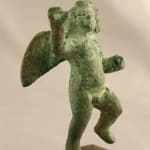Roman Bronze Sculpture of Cupid, 1st Century CE - 3rd Century CE
Bronze and Glass
2 x 2.75
CK.0163
Further images
In the vast Hellenic pantheon few gods have enjoyed such an indelible status as Cupid, the Roman god of love and eroticism. With his mythic bow and quiver, the nude...
In the vast Hellenic pantheon few gods have enjoyed such an indelible status as Cupid, the Roman god of love and eroticism. With his mythic bow and quiver, the nude youth has assumed an iconic personage in popular culture; seldom with such pertinence have pagan religious icons transcended the lacunae between antiquity and the contemporary. Borrowing on Greek religious traditions, the Romans worshiped Cupid as an important deity alongside the cult of Venus—that venerated goddess of love and beauty. Like many deities, Cupid’s lineage is disputed and pluralistic, owing to the diverse and often contradictory mythology that evolved from the Mediterranean’s rich oral traditions. Nonetheless, Cupid endures in Western civilization as the very avatar of romance, elucidating the mystery of sex that was for the Romans as perplexing and mystical as it is today. With his mischievous bow and puckish guise, Cupid illuminates the ethereal joys and harrowing depressions of love—that universal and eternal condition that both liberates and enslaves the human race.
This small bronze sculpture depicts Cupid, wings spread, mid-flight. Over the ages, the bronze has acquired a lovely green patina.
This small bronze sculpture depicts Cupid, wings spread, mid-flight. Over the ages, the bronze has acquired a lovely green patina.







